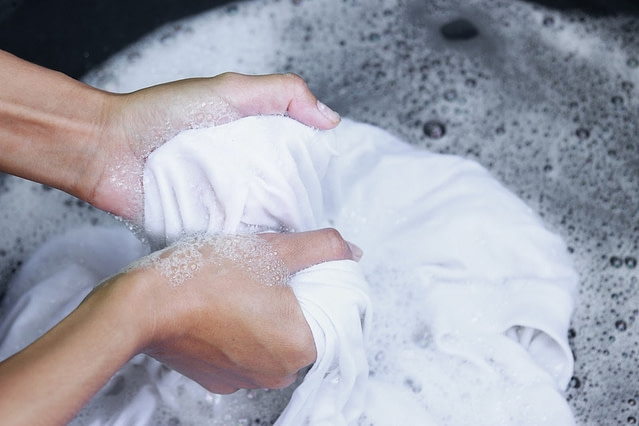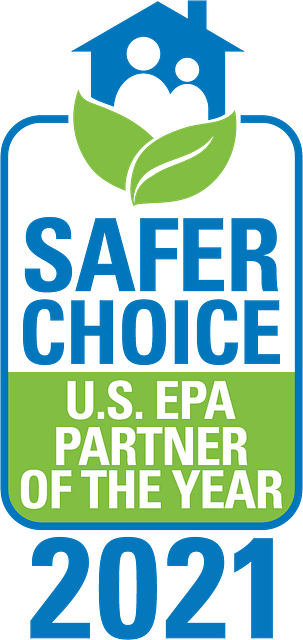4 Tips on How to Wash White Clothes
6 minute read

That classic, crisp tee. That chic, wintry knit. Those jeans. You know the pair. Those bright, tight, brilliant white jeans that once made your backyard barbecue feel like a sunset in Mykonos. There’s a reason why our white clothes make such essential pieces. They keep us looking sharp all year long and they go well with everything.
And when we say everything, we mean everything—including, unfortunately, stains. Our finest, freshest whites can become dulled or tainted over time, whether from dropped forks, coffee spills, or less-than-perfect washing habits.
So, how do you wash white clothes? Is it even possible to protect our best and brightest pieces?
It is, and you’ve come to the right place. (Here, it’s always laundry day.) To help you give new life to your go-to whites, we’ll let you in on our 4 best tips for how to wash white clothes. Just grab your plant-powered laundry detergent, read on below, and start feeling empowered to drink your morning coffee in that white sweater.
#1 Wash Whites Separately
You know what’s just as important as properly washing your white clothing? Knowing how to wash colored clothes – separately, that is.
Always wash your whites separately from the rest of your laundry. Take our word for it. We know that laundry day can be a headache, and we wouldn’t even think about adding an extra step to your routine unless we thought it could make a big difference.
But this? This is that extra step that makes all the difference. Through literal loads of experience, we’ve come to understand that washing your whites separately from your bright and dark-colored clothing is the single-best method to keep all your white washables looking their best.
There is one very good reason for this rule: Dark and bright clothing can bleed dye into the wash water, slowly discoloring your whites. Even lightly dyed or older clothing can release small amounts of dye. While the result may not be immediately visible, your whites will begin to look dingy and yellowish or gray.
Looking for a quick tip on how to separate laundry? Our favorite trick for keeping your white wash separate from your colored and bright wash is to purchase a divided hamper. Having a built-in system that allows you to organize your wash into whites and colors saves you the hassle of picking through a pile of dirty clothes on laundry day.
#2 Don’t Let Stains Set
We know the panic well—the mad dash to find a napkin and a seltzer water. But no matter how careful we try to be, we always manage to let something slide. Sometimes that something is a slider, loaded with ketchup and hell-bent on destruction.
So what can we do to prevent tough stains? Perhaps it’s better to start with what we shouldn’t do—let stains get comfortable. To that end, let’s talk about spot-treating and pre-treatment.
Here’s why. If you’re washing whites for general freshness, it’s fine to toss them into your hamper as-is. However, if you have a stain or noticeable soil on your white garment, bedsheet or towel, pre-treating the area as soon as possible might save you a lot of hard work once it sets.
Here’s how we tackle stains on white fabric.
Spot-Treat Small Stains
As soon as you notice a stain on your whites, do your best to blot it away. Don’t rub the stain; instead, use a small napkin or cloth to soak up as much as possible. Once this is accomplished, or if the stain is already dried, you need to pre-treat the stain before placing the stained item in your washing machine.
Pre-Treat Before You Wash
After you’ve blotted the stain, sworn off black coffee forever, finally calmed your nerves, and blotted once more, it’s time to pre-treat the spot.
Here’s the method that we use:
- Pick a mineral-based, bleach-alternative treatment that’s tough on stubborn stains but gentle on the environment and your skin, like ECOS OxoBrite Multi-Purpose Stain Remover.
- Fill your washing machine, bathtub, or sink with warm water and add two scoops of OxoBrite per gallon of water. Add your soiled clothing and soak overnight to allow the treatment to lift the stains and brighten your white garments, then wash normally.
- For extra tough stains, mix ½ ounce of laundry detergent with ½ scoop of OxoBrite into a paste and work into the stain with an old, soft toothbrush or towel. Let sit for 15-20 minutes, then rinse and wash normally.

#3 Get the Cycle Right
As the saying goes, it all comes out in the wash. Sadly, we’ve found that this can sometimes be true of the brightness in our whites.
Thankfully, using the right settings on our washers and dryers makes the difference between a dull, gray finish and a brilliant, white one. While some generalities may help point us in the right direction, we recommend that you read your washer and dryer manuals to figure out exactly what each setting means.
Washing Whites
Modern washing machines allow us to program specific characteristics of the cycle we want for every load. Many even come with pre-set programs such as:
- Heavy Duty
- Delicates
- Quick Wash
- Darks
- Normal
- Sheets/Towels
- Whites
At a minimum, however, our washers should allow us to manually program the following:
- Wash temperature
- Load size
- Spin cycle speed
Although we suggest checking the label on an item before washing, in general, white cotton fabrics and natural white fibers can get clean using cold water and a laundry detergent designed to clean white garments effectively in cold water, like ECOS Plastic-Free Laundry Detergent Sheets.
For washing delicate whites, we like to use a mesh laundry bag to protect them from snagging and tearing and wash them on the Delicate cycle only.
Drying Whites
Like modern washing machines, modern dryers have a menu of settings that can leave us feeling perplexed. From automatic dry-sensing to timed drying and from hot to cool temperature, there are many paths to tumble down.
But what’s the best dry? It depends on what’s in your laundry. We recommend tailoring your drier settings to suit different kinds of fabrics.
- Drying most natural-fiber whites (not wool though) on a hot setting won’t cause damage, but synthetic whites and delicates should only be dried on a warm or cool setting.
- Although you can certainly machine dry any of your whites, you might consider line drying all of them. Line drying in direct sunlight brightens whites using direct UV exposure and reduces energy consumption. If you dislike the roughness of line-dried clothes, you can always pop the whites into your machine dryer for a tumble once they are line-dried.
#4 Know Your Agents of Clean
Some cleaning solutions promise the purest whites but leave behind a toxic residue on our clothing, our bodies, and our planet.
We recommend steering clear of those cleaning ingredients that have been shown to negatively impact health, safety, and the environment, including:
- Optical brighteners
- Parabens
- Phthalates
- Formaldehyde
- PEGs
- QUATs
- Chlorine bleach

One easy trick is to look out for the Safer Choice seal on your laundry products. This little logo means the detergent is EPA certified and uses the safest-in-class ingredients for human and environmental health, without sacrificing performance. Not to brag, but we have over 150 Safer Choice certified cleaning products, including all of our laundry detergents.
Wellness and Whites: Why You Shouldn’t Reach for Bleach
It used to be that chlorine bleach was the go-to agent for getting whiter whites. In fact, “It’s okay honey, we’ll just bleach it” might have been the motherly mantra of a messy childhood.
But here’s the thing—bleach can actually do way more harm than you might realize. Bleach damages not only our clothes but also our bodies and the environment:
- Bleach reacts – Bleach is highly reactive and can produce toxic fumes if mixed with other common household cleaners.
- Bleach burns – Even in small amounts (like a capful of detergent), bleach can irritate our skin, eyes, and lungs.
- Bleach degrades – The manufacturing and industrial use of bleach creates toxic byproducts that can pose harm to fragile ecosystems.
Luckily, there’s a safer, more effective way to clean our whites. With ECOS plant-powered laundry detergents and stain removers, a thorough clean can also be a gentle clean, thanks to our formula is 100% vegan formulas and safer, sustainable ingredients, including:
- Enzymes – These naturally occurring proteins help speed up chemical reactions to break down stains.
- Minerals – These salts are Mother Nature’s stain-lifters.
- Plant-Based Surfactants – Cleaning power made from plant sources like coconuts are renewable and sustainable
Brighter Days and Whites With ECOS
Whether you’re laundering a latte-splattered shirt or a pie-stained dress, ECOS has your back. And front and sides. For over 50 years, we’ve been laser focused on bringing sustainably manufactured plant-powered cleaning products to every home.
